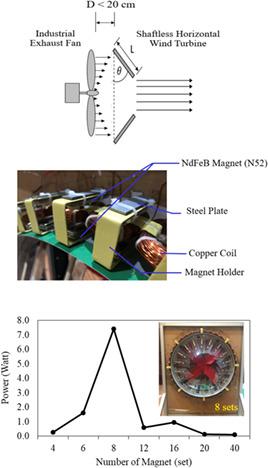当前位置:
X-MOL 学术
›
Int. J. Energy Res.
›
论文详情
Our official English website, www.x-mol.net, welcomes your
feedback! (Note: you will need to create a separate account there.)
Early development of a shaftless horizontal axis wind turbine for generating electricity from air discharged from ventilation systems
International Journal of Energy Research ( IF 4.3 ) Pub Date : 2020-11-23 , DOI: 10.1002/er.6221 Wachira Puttichaem 1 , Sompong Putivisutisak 2 , Yuttanant Boonyongmaneerat 3 , Pakpachong Vadhanasindhud 4
International Journal of Energy Research ( IF 4.3 ) Pub Date : 2020-11-23 , DOI: 10.1002/er.6221 Wachira Puttichaem 1 , Sompong Putivisutisak 2 , Yuttanant Boonyongmaneerat 3 , Pakpachong Vadhanasindhud 4
Affiliation

|
The air discharged from ventilation systems is a high potential wind resource for generating electricity in countries where wind speed is unreliable or weak, such as in Thailand. The air discharged from ventilation systems produces consistent and high-speed wind when benchmarked against natural wind. However, the limitations of conventional wind turbines are that they have negative impacts on the ventilation system and are inconvenient to install in many areas. The innovative shaftless horizontal axis wind turbine (SHWT) introduced in this article has been designed to close the gap between the wind source and the conventional wind turbines in this process. The concept design shows how it could be mounted next to sources of waste wind, requiring only a small space for installation. An open hole is provided to enable airflow to be discharged into the environment. This SHWT has high market potential for utilizing man-made wind to generate electricity from an alternative source which supports sustainable energy development. The purpose of this study is to demonstrate the concept design of a prototype SHWT used for energy recovery from the discharged air of a ventilation system. How the rotor and stator design of the SHWT optimize wind turbine performance and minimize the negative effects on the ventilation system efficiency are also addressed in this study. The performance of the SHWT is demonstrated in a lab-scale test using the type of propeller fan that is generally applied in many sectors in Thailand. The results showed that the SHWT was successful in generating electricity and produced minimal negative effects on the ventilation system's performance. The maximum power output of the prototype SHWT is 7.4 W at a rotational speed of 1644 rpm using eight sets of magnets and 5.1 m/s wind speed. The maximum wind turbine efficiency is 51%. However, it still requires further optimization to enhance the SHWT performance.
中文翻译:

用于利用通风系统排放的空气发电的无轴水平轴风力涡轮机的早期开发
从通风系统排出的空气是用于在风速不可靠或微弱的国家(例如泰国)发电的高潜力风力资源。当以自然风为基准时,从通风系统排出的空气会产生一致且高速的风。然而,传统风力涡轮机的局限性在于它们对通风系统有负面影响,并且在许多地方安装不方便。本文介绍的创新无轴水平轴风力发电机(SHWT)旨在缩小风源与传统风力发电机在此过程中的差距。概念设计展示了如何将其安装在废风源旁边,只需要很小的安装空间。提供一个开放的孔,使气流能够排放到环境中。该 SHWT 在利用人造风从支持可持续能源发展的替代来源发电方面具有很高的市场潜力。本研究的目的是展示用于从通风系统排出的空气中回收能量的原型 SHWT 的概念设计。本研究还讨论了 SHWT 的转子和定子设计如何优化风力涡轮机性能并将对通风系统效率的负面影响降至最低。SHWT 的性能在实验室规模的测试中得到了证明,该测试使用泰国许多部门普遍使用的螺旋桨风扇类型。结果表明,SHWT 在发电方面取得了成功,并且对通风系统的性能产生的负面影响最小。原型 SHWT 的最大功率输出为 7.4 W,转速为 1644 rpm,使用八组磁铁和 5.1 m/s 风速。最大风力涡轮机效率为 51%。但是,它仍然需要进一步优化以提高 SHWT 性能。
更新日期:2020-11-23
中文翻译:

用于利用通风系统排放的空气发电的无轴水平轴风力涡轮机的早期开发
从通风系统排出的空气是用于在风速不可靠或微弱的国家(例如泰国)发电的高潜力风力资源。当以自然风为基准时,从通风系统排出的空气会产生一致且高速的风。然而,传统风力涡轮机的局限性在于它们对通风系统有负面影响,并且在许多地方安装不方便。本文介绍的创新无轴水平轴风力发电机(SHWT)旨在缩小风源与传统风力发电机在此过程中的差距。概念设计展示了如何将其安装在废风源旁边,只需要很小的安装空间。提供一个开放的孔,使气流能够排放到环境中。该 SHWT 在利用人造风从支持可持续能源发展的替代来源发电方面具有很高的市场潜力。本研究的目的是展示用于从通风系统排出的空气中回收能量的原型 SHWT 的概念设计。本研究还讨论了 SHWT 的转子和定子设计如何优化风力涡轮机性能并将对通风系统效率的负面影响降至最低。SHWT 的性能在实验室规模的测试中得到了证明,该测试使用泰国许多部门普遍使用的螺旋桨风扇类型。结果表明,SHWT 在发电方面取得了成功,并且对通风系统的性能产生的负面影响最小。原型 SHWT 的最大功率输出为 7.4 W,转速为 1644 rpm,使用八组磁铁和 5.1 m/s 风速。最大风力涡轮机效率为 51%。但是,它仍然需要进一步优化以提高 SHWT 性能。











































 京公网安备 11010802027423号
京公网安备 11010802027423号